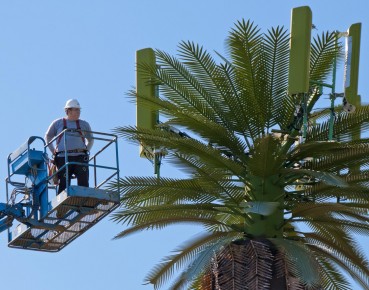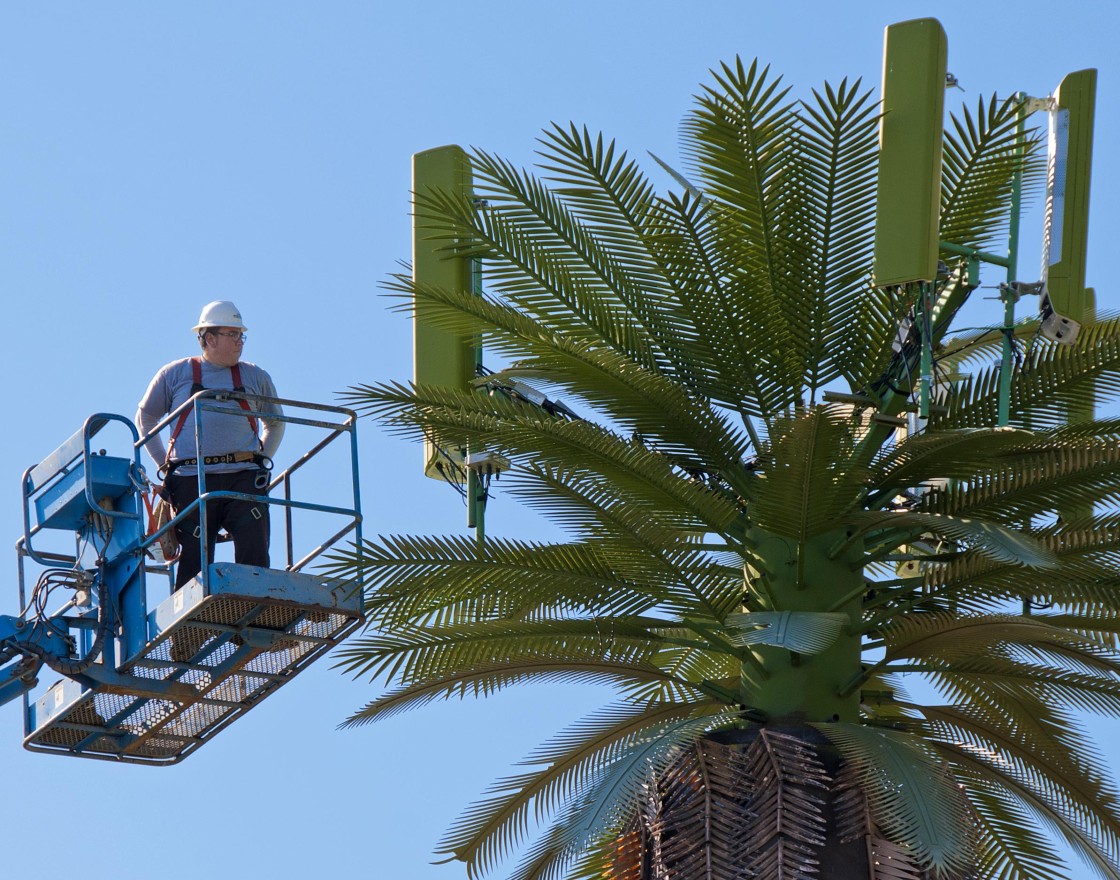Tydzień w gospodarce
Category: Trendy gospodarcze

(Russ Allison Loar, CC BY-NC-ND 2.0)
Even a partial fulfilment of the promises made over the past several years by the hardware suppliers, and then by the mobile operators, will only be possible after the launch of the “real” 5G network, that is, one functioning without the use of 4G networks and utilizing wide frequency bands.
“The 5G technology will be the next step in the evolution of wireless connectivity. Compared with previous generations of mobile networks, it will provide up to 20 times faster data transfer rate (up to 10 Gb/s when uploading and up to 20 Gb/s when downloading). It will also greatly reduce communication latency (to just one millisecond), and will allow for an increase in the number of devices connected to the network (to as many as one million devices per square kilometer),” write the authors of the report entitled “5G: Opportunities, threats and challenges”, which was published in early May 2020 by the Kościuszko Institute in collaboration with the Digital Poland Foundation.
The authors further add that, “the 5G network will not only contribute to economic growth and foster entrepreneurship, but it will also directly affect the daily lives of citizens. This will become possible due to the broad array of technological innovations featured in the functioning of 5G networks.” These innovations include: innovative Massive MIMO antennas; new relays equipped with microcells, picocells and femtocells; the Mobile Edge Computing (MEC) concept; the beamforming technology; network softwarization, which allows the separation of distinct layers in the process of network slicing, as well as the virtualization of network elements and separation of hardware from the software (Network Functions Virtualization — NFV; Software Defined Networking — SDN).”
The networks launched this spring in Poland — or more precisely, in the limited areas in which services are available in 5G — are indeed compatible with the 3GPP industry standard but use very limited spectrum resources. This means that the parameters they offer — throughput, commonly known as speed, and latency — are at the most comparable to the already functioning advanced LTE-A networks, which use the aggregation of several appropriately wide frequency bands. Moreover, these parameters are a far cry from the promises mentioned in the “5G: Opportunities, threats and challenges” report.
Polkomtel, which boasts of launching the first commercial 5G service in Poland, informed that, “the maximum technological speed of the network is 600 Mb/s.” In other words, this is the maximum speed available in laboratory conditions. In reality the network’s actual speed will be lower.
Meanwhile, Michał Ziółkowski, a member of the management board and the technical director at P4, the operator of the Play mobile network, claimed in early January during the presentation of the “First 5G network in Poland” that there shouldn’t be any problem with reaching data rates of 300 Mb/s.
Just like Play and Orange, the T-Mobile launched a 5G network in the 2100 MHz band. It is based on the Dynamic Spectrum Sharing (DSS) technology in which the same frequency is utilized both by the 5G and the 4G LTE technologies. The operator claims that the network’s maximum speed could reach 300 Mb/s — this includes spectrum aggregation, or the simultaneous use of the 4G LTE network in the 800 MHz band. Orange has not officially declared the speed of its 5G 2100 MHz DSS network, but it’s unlikely to be any higher than that of T-Mobile. This is because the operators intend to allocate up to 10 MHz of spectrum in the 2100 MHz band on their 5G networks, which is four times less than what Polkomtel allocated in the 2600 MHz band.
For a long time, Orange claimed that it did not intend to launch a 5G network in the 2100 MHz band. In an interview with a Polish daily“Rzeczpospolita” in January 2020, the outgoing president of Orange Poland, Jean-Francois Fallacher stated bluntly that the operator could “run a 5G network across Warsaw at a speed of more than 400 Mb/s” using the already controlled frequency blocks in the 2100 MHz band, just like P4 was doing. Mr. Fallacher pointed out, however, that the company was not doing that, because it wanted to “provide Orange customers with genuine 5G, and not a sub-standard substitute.”
Orange ultimately changed its mind. Witold Dróżdż, the member of the management board responsible for strategy, explained in June 2020, in an interview with the news agency ISB, that the main reason for this reversal was the delay in the allocation of the frequencies dedicated to the fifth-generation cellular mobile technology. “In light of the cancellation of the 5G auction, we decided to implement a solution based on the 2100 MHz band, which we already control, and which is now mainly used for 4G LTE,” said Mr. Dróżdż.
For the time being the Polish 5G networks will not include the mobile edge computing and network slicing technologies mentioned in the report, which are supposed to constitute an inseparable part of the “real” 5G network. There will also be no Massive MIMO systems enabling transmission and reception from multiple antennas simultaneously (32, 64, or even more than 100 antennas at the same time), and no beamforming technology, which enables directional transmission of the signal and is used at high frequencies. In this case, we will also have to wait for the implementation of the “real” 5G network.
Finally, at this point there are no concrete discussions concerning the new network’s possible industrial applications, such as local networks in factories, technology and industrial parks, as well as seaports and airports. This will also have to wait for the allocation of the 3.6 GHz and the millimeter-wave (above 6 GHz) frequency bands. Meanwhile, there are already a few models of smartphones and routers on the market, which can be used by the first Polish customers of the 5G network.
Some have claimed that the 5G network in the version currently offered by the Polish operators could compete with fixed broadband connections, including fiber optics connections. When we compare the maximum speed of Polish 5G with the minimum speed offered by cable and fiber optic networks, there are no major differences. However, in practice the 5G data rates will be much lower than the maximum, which means that cable and FTTH/B operators will prevail.
They will also win because they don’t have any limits on the transferred data. All the people who worked or studied remotely in March using only a mobile internet connection have learned the importance of high-speed data transmission and the lack of data limits.
This doesn’t mean that in the future the “real” 5G network, i.e. a network based on frequencies designed for this technology and wide blocks of bandwidth, with its own core network, as well as advanced technologies enabling the use of multiple antennas simultaneously (e.g. MIMO 64×64), will not be able to compete with fixed connections. Such a bet was taken by the operators in the United States — such as Verizon — who are already offering so-called fixed wireless access services (FWA).
According to surveys carried out by Nokia and the company Parks Associates in South Korea, the United States and the United Kingdom, the 5G FWA is one of the applications of the fifth-generation wireless technology most anticipated by consumers as well as small and medium-sized companies.
The respondents interviewed during the pandemic emphasized that the cost of such services cannot be higher than those of fixed broadband while their parameters should be comparable.
Ericsson is also optimistic about the future of FWA. In the June edition of the “Ericsson Mobility Report” the company described it as a cost-effective technology for delivering high-speed internet to locations where it makes no sense to build high-speed fixed connections.
Today, the introduction of the 5G network in the 2100 MHz band mainly seems to be a marketing move. The network will gain more importance in the future. As Mr. Dróżdż points out, it is the first step towards 5G. “In the future, the band now used for #hello5G (this is how Orange calls its 5G services in marketing materials — author’s note) will be a part of a multi-band 5G network, and will, among other things, help improve coverage inside buildings,” said Mr. Dróżdż in the interview with ISB.
This is already the case in Switzerland, where the local operator Swissom has been implementing a step-by-step strategy for the introduction of a 5G network. In October 2015, the company presented a three-point plan for the implementation of the 5G network. One of its elements was the shutdown of the 2G network at the end of 2020 and the allocation of the freed-up frequencies for technologies which — like LTE and 5G — ensure the efficient use of the band, that is, enable the transfer of more data.
In February 2019, Swisscom was granted 5G network frequencies in the 700 MHz, 1400 MHz, and 3.6 GHz bands. In April 2019 it launched the new network in 102 locations in 54 cities. The network development assumes a fast increase in the network coverage, and then also in the data transmission speed.
In order to achieve the first goal, in autumn last year the operator decided to turn off 3G services in the 2100 MHz band and to allocate the freed-up spectrum for the 5G network. As a result of these actions, at the end of last year Swisscom’s 5G network covered 90 per cent of the country’s inhabitants.
In locations where there is network coverage in the 3.6 GHz band the customers of Swisscom can benefit from a maximum data rate of up to 2 Gb/s. In the remaining areas covered by the 5G network the data rate reaches up to 1 Gb/s. According to the customers’ observations, in practice the network’s speed reaches up to 700 Mb/s at night and up to 250 Mb/s during the day.
Poland is not the only country where mobile operators are launching a 5G network using the already controlled frequency bands and the DSS technology instead of new frequencies dedicated to this technology.
Such a new network was launched in April in the Netherlands by VodafoneZiggo. Also in April 2020, Telekom Deutschland, the German operator from the Deutsche Telekom group, announced that by the end of this year more than half of Germany’s residents would be covered by a 5G network operating in the 2100 MHz band using the DSS technology. In June, the German operator unexpectedly accelerated these plans.
The Dutch VodafoneZiggo openly admitted that it had decided to build a 5G network using the DSS technology because in the Netherlands the 3.6 GHz band, which is the basic frequency for the European networks, will only be allocated in 2022. As this band is currently used for military purposes (satellite systems) it is impossible to accelerate the allocation of frequencies among the operators.
The network launched at the end of April initially covered half of the country. According to the operator, nationwide coverage was scheduled for the end of July. VodafoneZiggo also promised that the current version of its 5G network will reduce latency to 20 ms, i.e. by about 1/3 compared with the LTE network, and will increase the data rate up to 1 Gb/s. The operator announced that in practice the data rate is approximately 10 per cent higher than in the LTE network.
VodafoneZiggo did not inform which bands it was using. According to the media, the possible bands include 1800 MHz and/or 2100 MHz. The operator controls blocks of 2×20 MHz in both bands. In February 2020, VodafoneZiggo shut down 3G services in the 2100 MHz band and announced that the frequencies would be entirely dedicated to the 4G network. The German operator Telekom Deutschland launched the development of 5G infrastructure last year using the 3.6 GHz band dedicated specifically to 5G networks. The initial network was launched in eight cities (Berlin, Bonn, Darmstadt, Cologne, Munich, Hamburg, Frankfurt, and Leipzig).
The work was suspended, however, as a result of concerns regarding Telekom Deutschland’s main supplier — the Chinese company Huawei. Due to security issues, it is currently unclear whether Huawei will be able to supply 5G network equipment at all. For this reason, at the end of last year Telekom Deutschland froze its purchases of 5G equipment.
In April 2020, the German operator announced that it would initially use a 2×5 MHz spectrum block in the 2.1 GHz band for the needs of the 5G/LTE networks. The remaining resources would still be used by the 3G networks. According to the announcement made in April, the resources made available for 5G/LTE were to be tripled at the end of the year.
Meanwhile, in June 2020, Telekom Deutschland announced that it was accelerating its plans concerning 5G/LTE and launched commercial services in a network covering 16 million people in the country. The company informed that one month later its coverage would reach 40 million people, or half of Germany’s overall population. In addition, thanks to the previously obtained additional resources in the 2100 MHz band, the network would immediately operate with the use of a 2×15 MHz frequency block.
In big cities the 5G network operated by Telekom Deutschland has two speeds. In locations where the 3.6 GHz band is available the network’s maximum data rate can exceed 1 Gb/s. In the remaining urban areas, it should amount to 600-800 Mb/s.
Two other European operators — the German Vodafone and the Norwegian Telia — utilize the DSS technology to share the 700 MHz band between the LTE and the 5G networks. This band is ultimately intended for 5G networks operating primarily in areas with low population density.
In April, Vodafone Deutschland announced that it would use this frequency band to provide 5G services in rural areas and that by the end of the year 8000 antennas would be operating in 2800 locations. These services are being launched with the main objective of offering mobile, wireless internet access.
The 5G network of the Norwegian operator Telia has been operating in the same frequency band since May this year. This network also makes use of the DSS technology. By the end of 2021, the network is to cover half of the country’s residents and by 2023 it should reach complete coverage of the Norwegian population.


